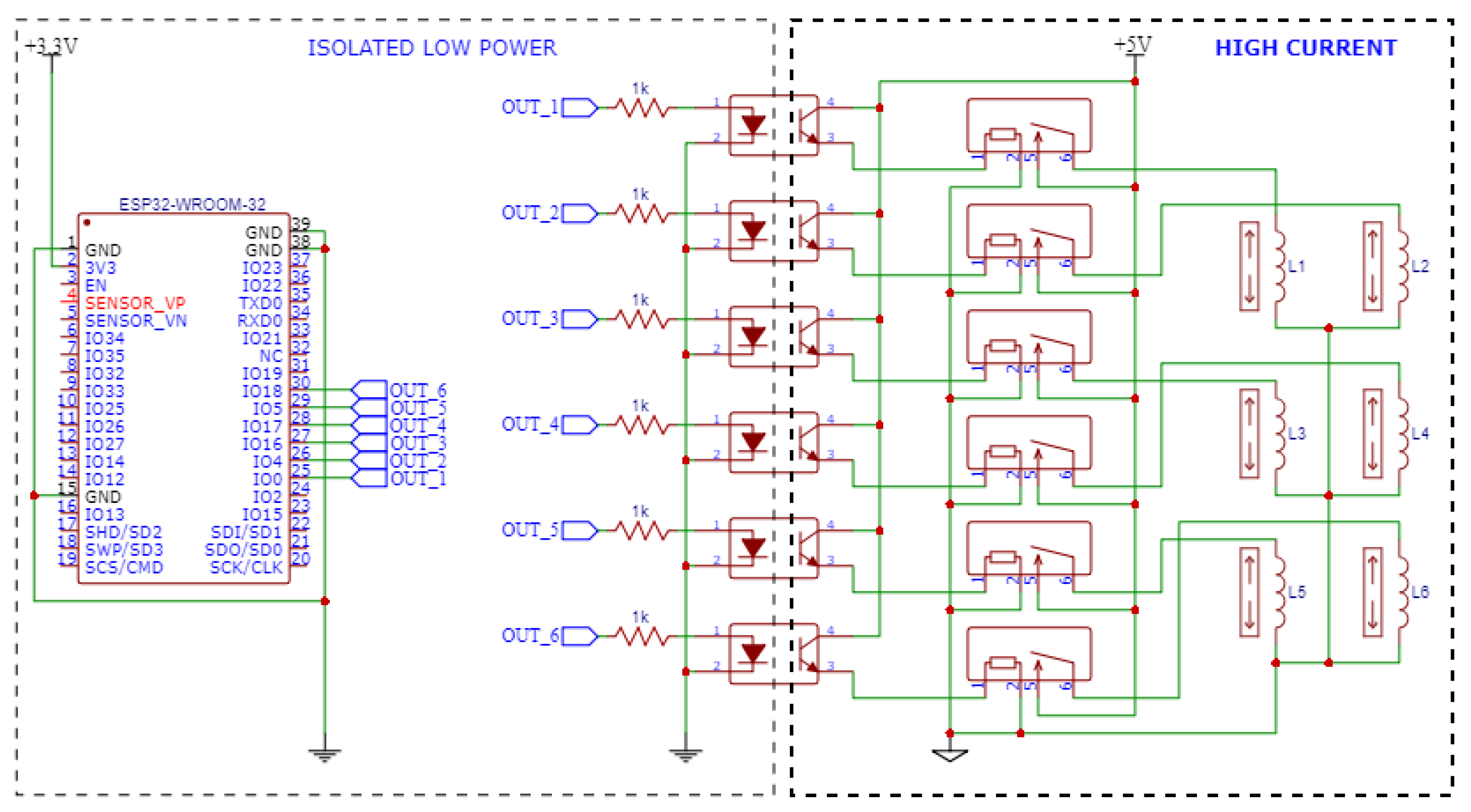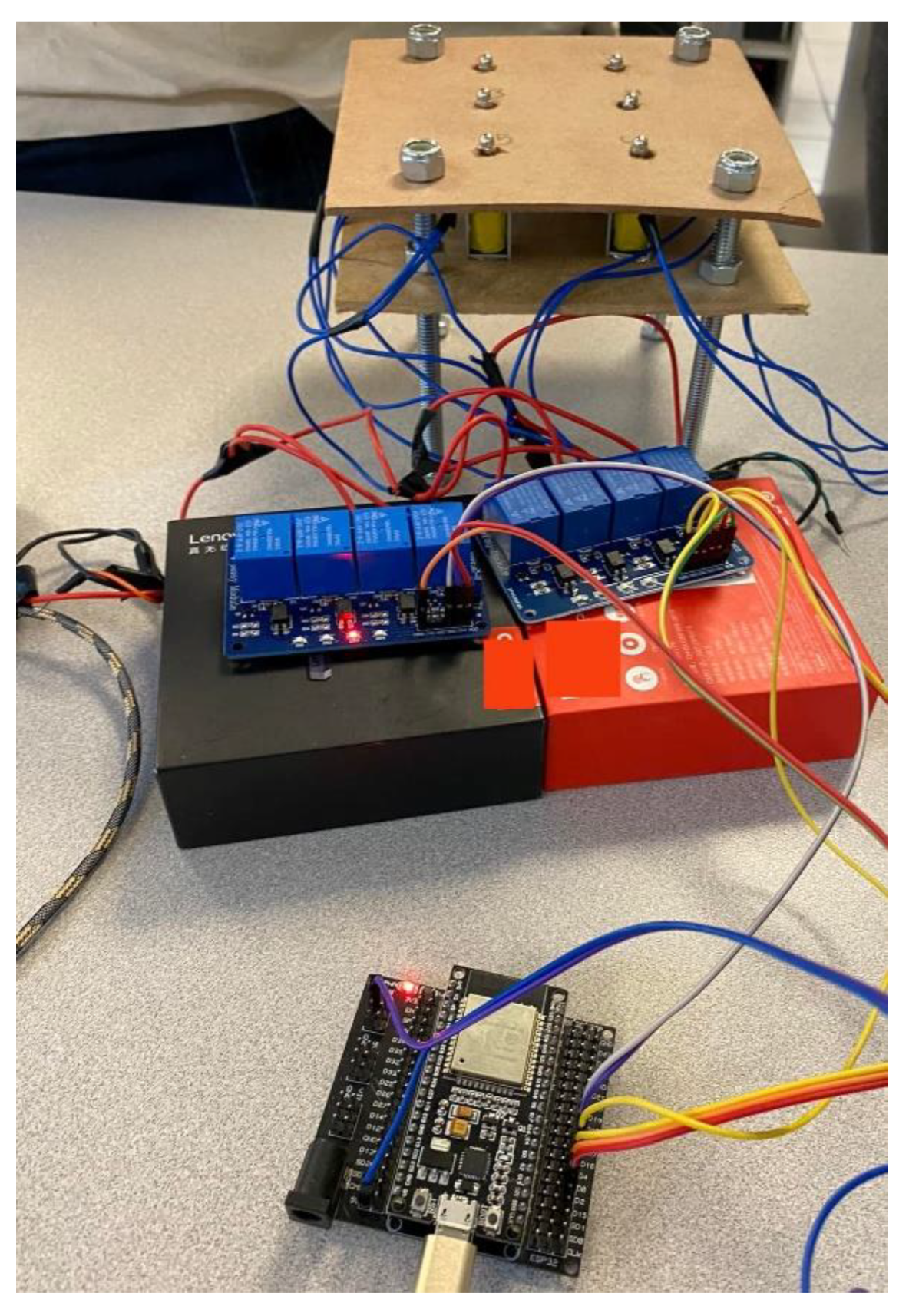1. Introduction
According to the World Health Organization, 2.2 billion people globally have some vision impairment [
1]. The impairment prevalence in low- and middle-income areas, like Mexico and Latin America, is estimated to be 400% higher than in high-income regions. In Mexico, 8.97 million people were identified with some visual impairment in 2020 [
2]. In addition, the blind and vision impairment population faces severe social and academic exclusion. For instance, children can undergo poor motor, language, and cognitive evolution, bringing lower levels of educational success.
Braille script represents a language’s characters in a rectangular arrangement of raised dots so that blind people can read the symbols and obtain written knowledge through the touch sense. Braille characters are generally printed in books or on commonly used surfaces, such as ATMs. However, printing is resource intensive as it needs to be done in each case. For this reason, electronic Braille displays were developed, which connect to a computer or smartphone and provide a tactile representation of the text displayed on the screen. Unfortunately, accessing this technology is difficult for people in developing countries because it is very costly.
Hence, this paper describes the design and development of a refreshable single-character Braille display that is affordable and easy to use through the Internet of Things (IoT) technology. Reading is essential to acquire knowledge by allowing an affordable form of reading based on braille, a handy tool for teaching and training blind and visually impaired people can be reached.
2. Braille Displays as Assistive Technology
Screen readers are now gaining ground as assistive technology for blind and low-vision people as they are natively integrated into modern desktop and mobile operating systems. Although Braille displays (also known as Braille lines) have been around for many years, their advantages over screen readers are that they allow for more significant user interaction [
3] and better usability [
4].
A wide variety of Braille displays for visual impairment are available, but due to cost reasons, they are mostly accessible only to the high-income population in developed countries. Attempts to develop Braille displays date back decades of research, with the main limitation being the actuator technology that can be used to interact with the user’s haptics. They have experimented with solenoids, shape memory alloys (SMAs), ferrofluids, Micro-Electromechanical Systems (MEMs), flexible polymers, and other materials [
2,
3,
4,
5,
6,
7]. In all cases, the main challenges are the weight, volume, energy consumption, and high costs of the devices developed.
A refreshable Braille cell is proposed to address these challenges and develop a device suitable for the local context, this research designed the device using push-pull electromagnetic solenoids connected to an ESP-32 microcontroller board. Each solenoid, when moved vertically, represents a braille dot that blind people can read from the device by touching.
3. Methods
The methodology used in this project was SCRUM [
5], which uses an agile approach to develop systems based on software and hardware. It is based on rapid iterations with specific objectives. This methodology was selected due to its flexibility to generate constant improvements since it seeks to provide functional prototypes in short periods.
3.1. System Architecture
Figure 1 illustrates the IoT system architecture for the Braille cell.
The architecture was designed based on the edge computing paradigm [
6,
7], enabling near real-time communication close to where the data is generated, that is, the edge of the Internet [
8]. Avoiding the steps of sending information from an internet-connected device to the cloud, from which the Braille cell must read the information, which results in faster communication between software and hardware.
Communication between the device and the contents to be displayed in the Braille cell is done through the Message Queuing Telemetry Transport (MQTT) protocol, a well-known IoT messaging protocol that was used to transmit the digital text and convert it to physical braille text. MQTT uses a publish and subscribe model, which typically operates with a small network overhead. This attribute makes it flawless for operating on microcontrollers in edge computing applications that demand high-speed data communication between devices over a wireless local area network (WLAN).
3.2. System Design
Figure 2 shows the prototype hardware. The central elements are the digital processing and control phases implemented within an ESP32-WROOM microcontroller board. This device was selected because it has integrated Wi-Fi (802.11 b/g/n up to 150 Mbps), a 32-bit dual-core Xtensa LX6 processor operating at 240 MHz, 4 MB of Flash memory, and 520 KB of SRAM, and digital terminals. This is sufficient for controlling the actuators that produce the sequences of the Braille symbols.
Six solenoids were used to display the tactile symbols on the matrix, which due to their nature, operate with higher voltage and current than the digital system can supply. Hence, an external power source capable of providing 5 V and a current of 9 amps is required.
The schematic diagram presents two blocks separated according to their operating voltage and current: one low power and one high current. As seen in these blocks, the digital control terminals are isolated with six optocouplers to ensure the block’s protection from discharges up to 5 kV, while the high current fed into each solenoid is controlled independently by activated relays through the output of the corresponding optocoupler.
4. Results
Figure 3 shows the prototype developed in this iteration of the methodology. As can be seen, the structure was built with wood since it represents a lower cost than 3D printing and is durable and resistant.
At the top is the cell in the form of a 2 × 3 matrix, whose pins are visible when they are in the active state, representing a Braille character.
Testing
The effectiveness of the prototype was tested using the battery of tests proposed in [
9]:
In-sequence-character output accuracy test.
Random-character output accuracy test.
Correct display of pins during reading mode.
All tests were passed successfully.
5. Discussion
During the first iterations, the control system maintained the active state of the solenoids to represent the Braille letters indefinitely. However, over time, excessive power was found to be dissipated by these devices in the form of heat, which means high power consumption and risk of damage, including fire. To address these challenges, the solenoids were programmed to be activated for only four seconds, enough time for each of the symbols to be interpreted and keep them inactive the rest of the time.
The solenoids used in the project were one of the few options available in Mexico, as it was impossible to obtain others with more desirable characteristics, such as low operating voltage, a higher impedance of the inductor, and even smaller physical dimensions to organize them for the size of a single fingerprint. Due to this, in the project’s next iteration, various hardware components that can achieve the miniaturization of the Braille cell and reduce energy consumption are analyzed.
6. Conclusions
With the development of this work in progress, it was demonstrated that creating a Braille cell with accessible costs for the local context is possible. The following stages of the project will consist of reducing the prototype’s size and carrying out tests with users to validate its usability, usefulness, and efficacy.
Author Contributions
Conceptualization, P.C.S.-M., L.S.G.-L. and S.B.F.-F.; methodology, P.C.S.-M.; software, O.I.R.-G., A.A.V.-A., N.A.O.-P. and M.Á.R.-T.; validation, F.E.-G., L.S.G.-L. and S.B.F.-F.; formal analysis, P.C.S.-M. and F.E.-G.; investigation, O.I.R.-G., A.A.V.-A., N.A.O.-P. and M.Á.R.-T.; writing—original draft preparation, P.C.S.-M. and F.E.-G.; writing—review and editing, L.S.G.-L. and S.B.F.-F.; project administration, P.C.S.-M. All authors have read and agreed to the published version of the manuscript.
Funding
This research was partially funded by the Human-Computer Interaction Lab (IHCLab) of the School of Telematics at the University of Colima in Mexico.
Institutional Review Board Statement
Not applicable.
Informed Consent Statement
Not applicable.
Data Availability Statement
Not applicable.
Acknowledgments
The authors thank Esli Castellanos for his advice on developing the embedded software of the prototype.
Conflicts of Interest
The authors declare no conflict of interest.
References
- WHO. Blindness and Vision Impairment; World Health Organization: Geneva, Switzerland, 2021. [Google Scholar]
- INEGI. Población Con Limitación En La Actividad Para Ver (Personas); México en Cifras; Instituto Nacional de Estadística y Geografía: Aguascalientes, Mexico, 2020. [Google Scholar]
- Hatzfeld, C.; Khoury, M.E.; Nakic, C.; Staab, M.; Winterstein, T.; Schlaak, H.F. Electrothermal Actuators for Portable Braille Devices. In the Proceedings of Eurohaptics 2016; Springer: London, UK, 2016. [Google Scholar]
- Russomanno, A.; O’Modhrain, S.; Gillespie, R.B.; Rodger, M.W.M. Refreshing Refreshable Braille Displays. IEEE Trans. Haptics 2015, 8, 287–297. [Google Scholar] [CrossRef]
- Mariño, S.I.; Alfonzo, P.L. Implementación de SCRUM En El Diseño Del Proyecto Del Trabajo Final de Aplicación. Sci. Et Tech. 2014, 19, 413–418. [Google Scholar]
- Cao, K.; Liu, Y.; Meng, G.; Sun, Q. An Overview on Edge Computing Research. IEEE Access 2020, 8, 85714–85728. [Google Scholar] [CrossRef]
- Shi, W.; Cao, J.; Zhang, Q.; Li, Y.; Xu, L. Edge Computing: Vision and Challenges. IEEE Internet Things J. 2016, 3, 637–646. [Google Scholar] [CrossRef]
- Santana-Mancilla, P.C.; Anido-Rifón, L.E.; Contreras-Castillo, J.; Buenrostro-Mariscal, R. Heuristic Evaluation of an IoMT System for Remote Health Monitoring in Senior Care. Int. J. Environ. Res. Public Health 2020, 17, 1586. [Google Scholar] [CrossRef] [PubMed]
- Garcillanosa, M.M.; Apuyan, K.N.T.; Arro, A.M.; Ascan, G.G. Audio-Assisted Standalone Microcontroller-Based Braille System Tutor for Grade 1 Braille Symbols. In Proceedings of the 2016 IEEE Advanced Information Management, Communicates, Electronic and Automation Control Conference (IMCEC), Xi’an, China, 3–5 October 2016; pp. 439–442. [Google Scholar]
| Publisher’s Note: MDPI stays neutral with regard to jurisdictional claims in published maps and institutional affiliations. |
© 2022 by the authors. Licensee MDPI, Basel, Switzerland. This article is an open access article distributed under the terms and conditions of the Creative Commons Attribution (CC BY) license (https://creativecommons.org/licenses/by/4.0/).










